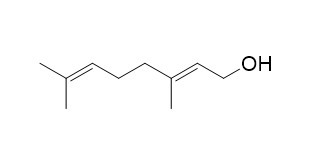cis-3,7-Dimethyl-2,6-octadien-1-ol
Reference standards.
Inquire / Order:
manager@chemfaces.com
Technical Inquiries:
service@chemfaces.com
Tel:
+86-27-84237783
Fax:
+86-27-84254680
Address:
1 Building, No. 83, CheCheng Rd., Wuhan Economic and Technological Development Zone, Wuhan, Hubei 430056, PRC
Providing storage is as stated on the product vial and the vial is kept tightly sealed, the product can be stored for up to
24 months(2-8C).
Wherever possible, you should prepare and use solutions on the same day. However, if you need to make up stock solutions in advance, we recommend that you store the solution as aliquots in tightly sealed vials at -20C. Generally, these will be useable for up to two weeks. Before use, and prior to opening the vial we recommend that you allow your product to equilibrate to room temperature for at least 1 hour.
Need more advice on solubility, usage and handling? Please email to: service@chemfaces.com
The packaging of the product may have turned upside down during transportation, resulting in the natural compounds adhering to the neck or cap of the vial. take the vial out of its packaging and gently shake to let the compounds fall to the bottom of the vial. for liquid products, centrifuge at 200-500 RPM to gather the liquid at the bottom of the vial. try to avoid loss or contamination during handling.
J of Health Science and Alternative Medicine2019, 1(1)
Food Chem.2020, 313:126079
Korean Herb. Med. Inf.2020, 8(2):243-254.
Appl. Sci.2021, 11(19),9343.
J Pharm Biomed Anal.2018, 151:32-41
Plant Physiol.2023, 193(3):1758-1771.
J. Traditional Thai Medical Res. 2022,8(1):1-14.
Separations2023, 10(11), 567;
J Sep Sci.2019, 42(21):3352-3362
Plants (Basel).2020, 9(11):1535.
Related and Featured Products
Plant Physiol Biochem, 2017:359-368.
Structural and kinetic studies of a novel nerol dehydrogenase from Persicaria minor, a nerol-specific enzyme for citral biosynthesis.[Reference:
WebLink]
Geraniol degradation pathway has long been elucidated in microorganisms through bioconversion studies, yet weakly characterised in plants; enzyme with specific nerol-oxidising activity has not been reported. A novel cDNA encodes nerol dehydrogenase (PmNeDH) was isolated from Persicaria minor.
METHODS AND RESULTS:
The recombinant PmNeDH (rPmNeDH) is a homodimeric enzyme that belongs to MDR (medium-chain dehydrogenases/reductases) superfamily that catalyses the first oxidative step of geraniol degradation pathway in citral biosynthesis. Kinetic analysis revealed that rPmNeDH has a high specificity for allylic primary alcohols with backbone ≤10 carbons. rPmNeDH has ∼3 fold higher affinity towards nerol (cis-3,7-Dimethyl-2,6-octadien-1-ol) than its trans-isomer, geraniol. To our knowledge, this is the first alcohol dehydrogenase with higher preference towards nerol, suggesting that nerol can be effective substrate for citral biosynthesis in P. minor. The rPmNeDH crystal structure (1.54 Å) showed high similarity with enzyme structures from MDR superfamily. Structure guided mutation was conducted to describe the relationships between substrate specificity and residue substitutions in the active site. Kinetics analyses of wild-type rPmNeDH and several active site mutants demonstrated that the substrate specificity of rPmNeDH can be altered by changing any selected active site residues (Asp280, Leu294 and Ala303). Interestingly, the L294F, A303F and A303G mutants were able to revamp the substrate preference towards geraniol. Furthermore, mutant that exhibited a broader substrate range was also obtained.
CONCLUSIONS:
This study demonstrates that P. minor may have evolved to contain enzyme that optimally recognise cis-configured nerol as substrate. rPmNeDH structure provides new insights into the substrate specificity and active site plasticity in MDR superfamily.



